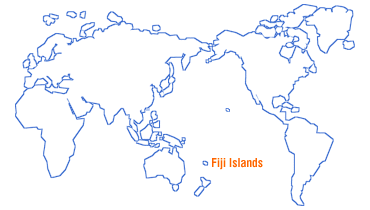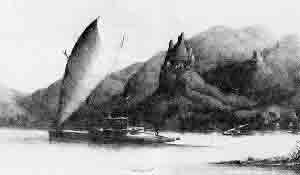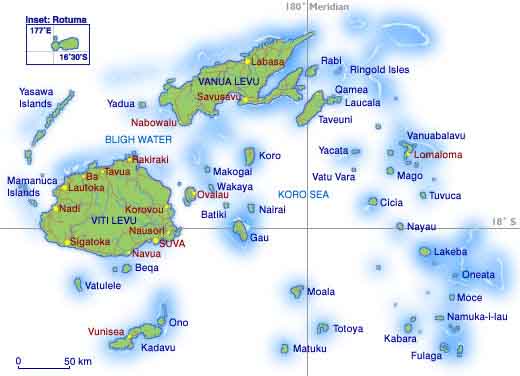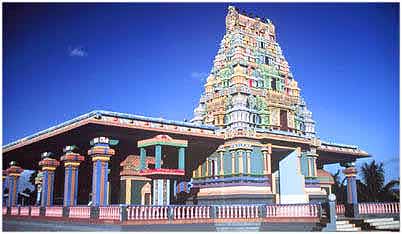
|
|||||||
|
| |||||||
Murukan worship in Fiji
by Dr. R. Ponnu S. GoundarArrival of Indians to FijiIndians were brought to Fiji by the British to work on sugarcane plantations. The first batch of Indians from North India arrived on the ship Leonidas in 1879. The first batch of three Indians from South India arrived on ship Elba in 1903. With the arrival of South Indians, Lord Murukan too arrived to the shores of Fiji Islands. The distance between India and Fiji is about 15,000 km
as the crow files. But our forefathers left India not
knowing where Fiji was. It took the ships some three to six
months to sail to Fiji, passing Indonesia, Papua New Guinea
and Australia. Those days ship sailing was left to the
mercy of the winds, for there were no steam powered ships.
One such sailing boat was wrecked on a reef in the night,
and all the Indian labourers met with their end no one to
cry for them.
The BeginningThe first Murukan temple was built around 1861 on the banks of Nandi River by Tiru Ramasami Pillai of Singarandapuram village, Razipur Taluq, Salem District, Tamil Nadu. After completing his five years as indentured labourer, he must have been driven by forces to undertake this task to build a temple for his ishta-devatā. First, the temple was just a thatched hut. To build a concrete temple Ramasami Pillai went around collecting money from the South Indian community in Fiji and built a large temple of the day, and in those days it was known as 'Periya Kovil'. So it remains today also in a new site as the biggest in the southern hemisphere.
Initially this was a private temple. Later Ramasami Pillai returned to India; and South Indians living in Nandi paid a sum of money and bought the temple in the name of Ten Intiya Canmarka Ikya Cankam. Since then the management of this Murukan temple has remained in the hands of the Cankam. A granite Murukan vigraha carved in Ten Kasi was acquired with the help of Tiru M. N. Naidu; the vigraha arrived in 1926. In 1931 a pañca-loha utsava vigraha Murukan with Valli and Teyvayānai arrived with the help of Tiru Yagambaram Reddy and some devotees of Sabeto settlement near Nandi airport. Among the 30 granite mūrtis shipped to Fiji from Chennai in the 1970s by Dr. N. Mahalingam, two dwāra pālakas adorn the entrance to the artha mandapam of our Murukan temple at the new site. FestivalsThe following festivals are observed:
Besides these Murukan festivals, Siva Rātri and Vināyaka Caturthi are also observed. Taip Pucam and Pankuni-Uttiram festivals have been
observed from the beginning. Taip Pucam is the
Brahma-Utsavam, observed for ten days in a grand manner. People from
every nook and corner of Fiji make a pilgrimage to this
Murukan temple. In those old days, when modern transportation
did not exist, the devotees had to walk the distance to
Nandi. Fiji is made up of some three hundred islands:
Indians live predominantly on the two big islands. Devotees
from Vanualevu came by boat. The devotees stayed at the
temple for full ten days and returned home after the flag
was lowered at festival's end.
Pankuni-Uttiram is the other important festival in the calendar of festivals at the temple. This is observed for three to five days. Murukan devotees look forward to Taip Pūcam and Pankuni-Uttiram with all eagerness to fulfil their vows. Indians who have migrated to England, Canada, America, Australia and New Zealand return to Fiji on these festival days to offer kāvati and pāl kutam. The first kāvati was offered in 1920 by Tiru Ambu Nair who walked about 90 km all the way. You can see the great devotion for Lord Murukan in this great devotee. On festival days the three meals are offered to thousands of devotees free. Devotees from overseas who cannot come to the festival send their donations, to be offered to Lord Murukan through their friends and relations living in Fiji. The Murukan devotees pierce their body with Vēl while offering kāvat i. This spectacle is witnessed by devotees with great reverence. Small ratams (chariots) with Murukan in it are pulled by devotees with their bodies hooked to the ratam. During two important festival days, i.e. Taippūsam and Pankuni Uttiram, the Utsavar with Valli and Teyvayānai are taken in a tēr through the streets of Nandi town. Devotees eagerly wait for the Lord to arrive at their doorstep to receive offerings. If, for some reason, the Lord is unable to go out riding in his chariot, the devotees are extremely disappointed. Observation of Kārttikai Tīpam was started by Tiru Arumugam Odaiyar who hailed from Tiruvannamalai. The exact date when this festival was started is not known. I remember this being observed as a boy in 1940s. This tradition has become a family pūja and is kept up by the descendants of Tiru Arumugam Odaiyar. Tiru M.N. Naidu, who came from Madurai, started Skanda Sas t i puja in 1956, when mayil in granite and Vēl were presented to Lord Murukan. Until then Nandi Murukan did not have a vāhanam or a proper Vēl. In this modern era, with better facilities of transport and communications, more devotees are flocking to the temple to fulfil their vows. Murukan Temples elsewhere in FijiNandi Murukan temple is the oldest and biggest temple in Fiji. Besides this temple, there are Murukan temples at Tagi Tagi, Koronubu and Navua. There are smaller and private family Murukan temples all over Fiji. When one visits these temples one can feel the holy vibrations surrounding these places of worship. Names of Tamil childrenIn earlier days it was common for newborn children, especially boys, were named after Murukan. Names such as Subramaniya, Ārumukam, Cinnacāmi, Murukan, Shanmukan, Vēlāyutan, Turaiswāmi, Kumāracāmi, Kuppucāmi, Pūnucāmi, Kantacāmi, etc. were once common. Among Tamil women's names of the earlier generation we can come across Valli Amma and Teyvayānai. Obviously these names were given purely out of devotion to Murukan. But nowadays Murukan names have become rare for two reasons. Firstly, Tamil language is a dying language in Fiji; and secondly Hindi language and Hindi cinemas have a strong influence on people including ethnic Tamils. Hindi has almost become the common language among Tamils in Fiji. Books about Murukan and his festivals have been published in English, but good literature is not available in Fiji. We receive few publications from India in general and Tamil Nadu in particular. NoteAs a second generation Fiji Indian of Tamil origin I am indebted to my parents first who induced the devotion to Murukan, enhanced by one Reverend Sadhu Kuppuswami - of course the same Murukan in another name as the deity of the coastal hamlets - who founded the Ten Intiya Camman kaIkya Cankam in Fiji, which manages a number temples in Fiji, including the Nandi Murukan temple, the largest temple in Southern hemisphere. It was again Sadhu Kuppuswami who later brought in Ramakrishna Mission swamis for further help, one of whom, His Holiness Swami Rudranandaji Maharaj, my guru, not only worked for the welfare of the sugar cane farmers, but also started the famous Śrī Vivekananda High School, of which I am proud to be one of the early students. I am conscious of the grace of Murukan who has made me and hundreds of others what they are today. The sincere prayers of our forefathers resulted in the all-round progress of Fiji. For more inforation, visit the Nadi Śrī Siva Subramaniya Temple home page or see 1994 Hinduism Today article or contact:
Index of research articles on Skanda-Murukan |




